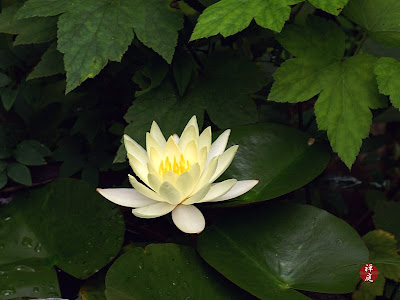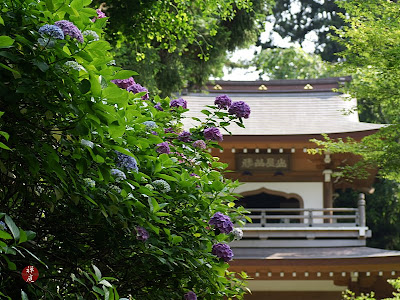
My photographic notes about the four seasons in Kamakura or the gardens of Zen
July 31, 2009
July 30, 2009
July 28, 2009
A sacred lotus flower in Kencho-ji temple

As the heat and sunlight of summer increase, the number and variety of flowers reduce rapidly. In this period of intense heat, numerous sacred lotus flowers flourish beautifully in the gardens of the temples and shrines of Kamakura.
Sacred lotus flowers grow and bloom bravely on the surface of a muddy water. Thus, in Asia, this flower symbolically represents the noble and brave manner of living in our impure world.
In the thought of Buddhism, a sacred lotus flower is the flower of Buddha and symbolizes his promised land of happiness.
July 21, 2009
July 15, 2009
July 13, 2009
A Shoukannzeon-Bosatsu statue in the garden of Tokei-ji temple

Sho-kanzeon-Bosatsu is sitting on a lotus flower which symbolizes the land of happiness of Buddhism.
This Bosatsu is one metamorphosis of the goddess of mercy in Buddhism and holds a lotus bud in her left hand and opens the palm of her right hand to display spiritual encouragement and great mercy to every living being.
This Bosatsu performs infinite mercy to save every living being from suffering infernal pains on the dark floor of Hell.
This Bosatsu performs infinite mercy to save every living being from suffering infernal pains on the dark floor of Hell.
July 9, 2009
A white dove at the Chouzu-ya of Tsurugaoka-Hachimangu

"Tyouzu-ya" (hand-washing house) is the place for spiritual purification that is situated in a temple or shrine.
Visitors to a temple or shrine must wash their hands and mouth at this place before entering into the sanctuary of the temple or shrine in order to symbolically purify their mind and body.
Tsurugaoka-hachimangu is located in the center of the historic area of old Kamakura and is one of the most respected shrines of Shintoism ( the ancient and inherent religion of Japan.) This shrine was founded in 1063 by Minamoto no Yoritomo, who is the first shogun of the Kamakura regime.
In the world of Shintoism, a white dove is regarded as the minister of divine will.
Blue Ajisai flowers floating in the stone basin at Engaku-ji temple
Flowers in the garden of Jochi-ji temple
July 8, 2009
A gardenia flower in Engaku-ji temple
A bamboo woods in Chojyu-ji temple
July 7, 2009
July 6, 2009
A waterlily flower in Engaku-ji temple
 A Suiren (water lily) flower repeats its cycle of opening (waking) in the early morning and closing (sleeping) in the late afternoon for a period of about 4 days.
A Suiren (water lily) flower repeats its cycle of opening (waking) in the early morning and closing (sleeping) in the late afternoon for a period of about 4 days."Suiren" is an aquatic plant and the Japanese name of Suiren means a sleeping lotus flower which is based on such a flowering manner.
I found this little white-yellow flower in the Suiren-bachi (water-basin for water lily) placed in the undergrowth of the garden.
A bamboo woods in Eisho-ji temple
A Byakusin (Sabina chinensis) tree in Kecho-ji temple
 A "Byakusin" tree is a typical and essential tree of the temples of Zen Buddhism. According to the teaching of old zen teachers, the unhurried and continuous growth of a Byakusin tree symbolises the gradual and ever-progressing process of the spiritual enlightenment in Zen Buddhism.
A "Byakusin" tree is a typical and essential tree of the temples of Zen Buddhism. According to the teaching of old zen teachers, the unhurried and continuous growth of a Byakusin tree symbolises the gradual and ever-progressing process of the spiritual enlightenment in Zen Buddhism.The gate shown in this picture is a gate to one of the Zazen training facilities of this Kenchou-ji temple.
July 3, 2009
Flowers of June in Kamakura
July 1, 2009
Zen garden in Zuisen-ji temple
 I visited the zen garden of Zuisen-ji temple which is called the Temple of Flowers.
I visited the zen garden of Zuisen-ji temple which is called the Temple of Flowers.This rock garden was designed by Muso Soseki who was one of the eminent zen teacher and garden architect in the golden era of Zen Buddhism of Japan.
A pond, caves, islands and a waterfall (not shown) are symbolically created in a huge mass of rock. There are three little wooden bridges across the pond.
Subscribe to:
Posts (Atom)








































